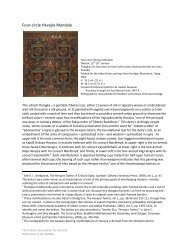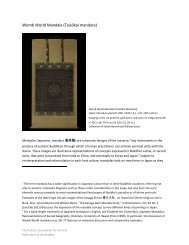Reflections of the Buddha - The Pulitzer Foundation for the Arts
Reflections of the Buddha - The Pulitzer Foundation for the Arts
Reflections of the Buddha - The Pulitzer Foundation for the Arts
You also want an ePaper? Increase the reach of your titles
YUMPU automatically turns print PDFs into web optimized ePapers that Google loves.
Cube Gallery<br />
Vajrayāna Buddhism<br />
<strong>The</strong> spiritual practices and rituals <strong>of</strong> Vajrayāna Buddhism include <strong>the</strong> use <strong>of</strong> verse (mantra) to invoke a deity or<br />
to gain protection and <strong>the</strong> visualization <strong>of</strong> a vast array <strong>of</strong> celestial <strong>Buddha</strong>s and bodhisattvas, many embraced<br />
from early Buddhism and Mahāyāna Buddhism. In this gallery are three sculptures representing some <strong>of</strong> <strong>the</strong><br />
most important bodhisattvas, along with three thangkas (portable paintings or hanging banners). Thangkas<br />
<strong>of</strong>ten portray a divinity’s cosmos or circle (mandala) as an architectural plan with gates and various levels leading<br />
to central pinnacles. Such Vajrayāna objects aid meditation and trance induction that connect <strong>the</strong> viewer<br />
with sanctity in <strong>the</strong> universe and within oneself, bringing enlightenment closer.<br />
11. Four Mandalas (dkyil-‘khor), 18th century<br />
Tibet; thangka; colors on cotton, mounted on<br />
silk brocade; 31¾ x 24 in.; <strong>The</strong> Nelson-Atkins<br />
Museum <strong>of</strong> Art, Kansas City, Missouri,<br />
Bequest <strong>of</strong> Joseph H. Heil, 74-36 /16<br />
Practioners wishing to receive <strong>the</strong><br />
blessing <strong>of</strong> an extended lifespan <strong>of</strong>ten<br />
meditated on <strong>the</strong> figure at <strong>the</strong> center <strong>of</strong><br />
this thangka, Amitāyus (<strong>the</strong> name given to Amitābha in<br />
his manifestation as <strong>the</strong> bestower <strong>of</strong> longevity). Colored<br />
red, he sits in a beautiful landscape on a lotus throne in<br />
meditation holding a vase containing <strong>the</strong> elixir <strong>of</strong> immortality.<br />
On ei<strong>the</strong>r side <strong>of</strong> him are lamas, Tibetan teachers <strong>of</strong><br />
<strong>the</strong> Dharma, who sit in foliage that bears fruit in <strong>the</strong><br />
<strong>for</strong>m <strong>of</strong> <strong>the</strong> Three Buddhist Jewels, representing <strong>the</strong><br />
<strong>Buddha</strong>, <strong>the</strong> Dharma, and <strong>the</strong> San� gha.<br />
12. Four-circle Hevajra Mandala (Kye-ba Rdo-rje<br />
dkyil-‘khor), 15th or 16th century<br />
Tibet; thangka mounted as an album leaf; ink<br />
and colors on linen; 21 x 17½ in.; Harvard<br />
Art Museums / Arthur M. Sackler Museum,<br />
Paul Bernat Fund, 1967.8<br />
This mandala helps <strong>the</strong> practitioner<br />
visualize <strong>the</strong> union <strong>of</strong> <strong>the</strong> male and female principles <strong>of</strong><br />
compassion and wisdom, respectively. This integrative<br />
process <strong>of</strong> opposites lies at <strong>the</strong> heart <strong>of</strong> Vajrayāna practice.<br />
By recognizing opposites as psychological distortions<br />
within oneself, <strong>the</strong>ir power over you is lessened and your<br />
path to enlightenment is accelerated.<br />
42<br />
13. Acala Candamaharosana (Budong Mingwang),<br />
“<strong>The</strong> Immovable One,” One <strong>of</strong><br />
<strong>the</strong> Five Great Wisdom Kings, 1764<br />
China, Qing dynasty, 1644 – 1912; kesi thangka<br />
mounted as a hanging scroll; silk in kesi tapestry<br />
weave with some details painted on <strong>the</strong> surface in<br />
gold and light colors; 35¼ x 21¼ in.; Harvard Art<br />
Museums / Arthur M. Sackler Museum, Gift <strong>of</strong> Mr.<br />
and Mrs. Earl Morse, 1958.8<br />
This tightly woven tapestry depicts Acala surrounded by<br />
four o<strong>the</strong>r wrathful deities. Terrifying deities are <strong>of</strong>ten<br />
visual metaphors <strong>for</strong> inner states that block enlightenment,<br />
such as anger, greed, fear, passion, and ignorance.<br />
Acala holds a sword and a lasso, evidence <strong>of</strong> his abilities<br />
to cut through obstacles, snare you, and bring you closer<br />
to enlightenment.<br />
14. Bodhisattva Avalokiteśvara (Karunamaya),<br />
late 10th or early 11th century<br />
Nepal, Transitional period, c. 879 – 1200; gilt<br />
copper alloy with inlays <strong>of</strong> semiprecious stones;<br />
26¾ x 11½ x 5¼ in.; Asia Society, New York:<br />
Mr. and Mrs. John D. Rockefeller 3rd Collection,<br />
1979.047<br />
Avalokiteśvara (Perceiver <strong>of</strong> <strong>the</strong> World’s<br />
Sounds) travels to all realms <strong>of</strong> <strong>the</strong> universe to deliver beings<br />
from suffering. He has a special mantra: Om Mani<br />
Padme Hum (“Hail <strong>the</strong> wish-fulfilling jewel and lotus”).<br />
This particular work is one <strong>of</strong> <strong>the</strong> earliest Buddhist sculptures<br />
to use semiprecious stone inlays, which became a<br />
distinctive feature <strong>of</strong> Himalayan sculpture. Sculptures<br />
like this one were highly revered in Tibetan monasteries,<br />
which helped spread <strong>the</strong>ir style to o<strong>the</strong>r parts <strong>of</strong> Asia,<br />
including Mongolia (see artwork 16).




